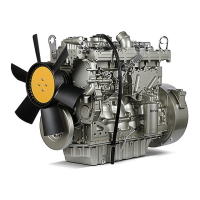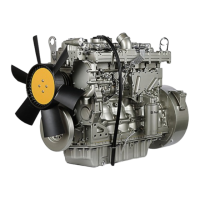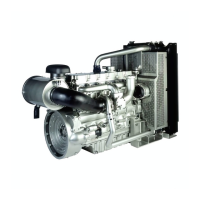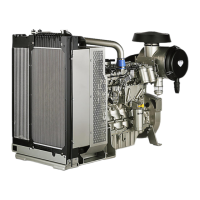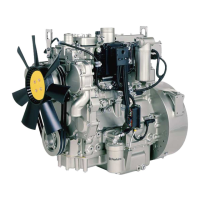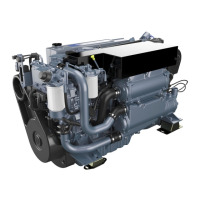Do you have a question about the Perkins 1106C-70TA and is the answer not in the manual?
Details on specific warning signs on the engine and their locations.
Warning regarding high-pressure fuel hazards, including fluid penetration and fire risk.
Warning against using aerosol starting aids due to explosion and personal injury risk.
Safety precautions when using pressurized air or water for cleaning.
Hazards associated with high-pressure fluid leaks and precautions.
Precautions when dealing with hot and pressurized coolant.
Safety warnings related to hot oil and components.
Safety precautions when servicing batteries, including electrolyte hazards.
Instructions for proper grounding of the engine electrical system.
Overview of the engine and its features.
Illustrations showing typical engine features with labels.
Key specifications for the 1106C-E70TA and 1106D-E70TA industrial engines.
Description of the engine's electronic control and monitoring features.
Information on the engine's built-in diagnostic system.
Information on the location of identification plates and films.
Spaces to record engine information for future reference.
Procedures for lifting and storing the engine.
Guidelines for safely lifting the engine.
Recommendations for storing the engine.
Description of engine alarms, shutoffs, and their functions.
Details on how engine alarms operate and are indicated.
Information on critical engine shutoff parameters and procedures.
Procedure for testing indicator lights and system functions.
Description of the warning mode and its indicators.
Description of the warning/derate mode and its indicators.
Description of the warning/derate/shutdown mode and its indicators.
Capabilities of the electronic engine for self-diagnostics.
Purpose and use of the diagnostic lamp for fault indication.
Procedure for retrieving diagnostic flash codes using the diagnostic lamp.
How active diagnostic codes affect engine operation.
Handling of intermittent diagnostic codes and their impact.
Pre-start checks and procedures for engine preparation.
Specific procedures for starting the engine in cold weather conditions.
Key considerations and tips for operating the engine in cold weather.
Importance of engine oil viscosity in cold weather.
Coolant recommendations for freeze protection.
Functionality and use of engine block heaters.
Procedures for warming up the engine in cold temperatures.
Components affected by cold weather and fuel properties.
Information on fuel heaters and their temperature limitations.
Proper procedures for shutting down the engine.
Guidelines for using emergency stop controls.
Capacities for engine fluids like oil, coolant, and fuel.
Refill capacities for engine oil.
Refill capacities for engine coolant.
Information on fuel tank capacity.
Recommendations for various fluids used in the engine.
General information and precautions regarding engine coolant.
Procedure for manually priming the fuel system.
Procedure for priming the fuel system using the electric pump.
Intervals for draining water and sediment from fuel storage tanks.
Performing a walk-around inspection for leaks and loose connections.
General information about engine warranty.
Information regarding emissions warranty coverage.
Details on reference materials and engine protection plans.
Details on specific warning signs on the engine and their locations.
Warning regarding high-pressure fuel hazards, including fluid penetration and fire risk.
Warning against using aerosol starting aids due to explosion and personal injury risk.
Safety precautions when using pressurized air or water for cleaning.
Hazards associated with high-pressure fluid leaks and precautions.
Precautions when dealing with hot and pressurized coolant.
Safety warnings related to hot oil and components.
Safety precautions when servicing batteries, including electrolyte hazards.
Instructions for proper grounding of the engine electrical system.
Overview of the engine and its features.
Illustrations showing typical engine features with labels.
Key specifications for the 1106C-E70TA and 1106D-E70TA industrial engines.
Description of the engine's electronic control and monitoring features.
Information on the engine's built-in diagnostic system.
Information on the location of identification plates and films.
Spaces to record engine information for future reference.
Procedures for lifting and storing the engine.
Guidelines for safely lifting the engine.
Recommendations for storing the engine.
Description of engine alarms, shutoffs, and their functions.
Details on how engine alarms operate and are indicated.
Information on critical engine shutoff parameters and procedures.
Procedure for testing indicator lights and system functions.
Description of the warning mode and its indicators.
Description of the warning/derate mode and its indicators.
Description of the warning/derate/shutdown mode and its indicators.
Capabilities of the electronic engine for self-diagnostics.
Purpose and use of the diagnostic lamp for fault indication.
Procedure for retrieving diagnostic flash codes using the diagnostic lamp.
How active diagnostic codes affect engine operation.
Handling of intermittent diagnostic codes and their impact.
Pre-start checks and procedures for engine preparation.
Specific procedures for starting the engine in cold weather conditions.
Key considerations and tips for operating the engine in cold weather.
Importance of engine oil viscosity in cold weather.
Coolant recommendations for freeze protection.
Functionality and use of engine block heaters.
Procedures for warming up the engine in cold temperatures.
Components affected by cold weather and fuel properties.
Information on fuel heaters and their temperature limitations.
Proper procedures for shutting down the engine.
Guidelines for using emergency stop controls.
Capacities for engine fluids like oil, coolant, and fuel.
Refill capacities for engine oil.
Refill capacities for engine coolant.
Information on fuel tank capacity.
Recommendations for various fluids used in the engine.
General information and precautions regarding engine coolant.
Procedure for manually priming the fuel system.
Procedure for priming the fuel system using the electric pump.
Intervals for draining water and sediment from fuel storage tanks.
Performing a walk-around inspection for leaks and loose connections.
General information about engine warranty.
Information regarding emissions warranty coverage.
Details on reference materials and engine protection plans.
